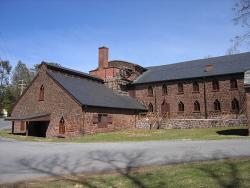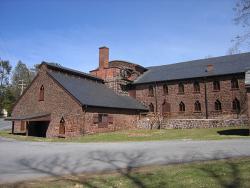When erected by Peter Grubb to smelt the rich iron ore of the nearby Cornwall ore banks, this stone-built blast furnace was typical for its time, producing about 20 tons of pig-iron and cast-iron products a week. A major reconstruction in 1856 to 1857 produced important changes: the furnace itself was enlarged; the blast-air bellows were replaced by a pair of wooden cylinder "blowing tubs"; the waterwheel that had powered them was replaced by a 20-horsepower steam engine; and a pair of waste-heat boilers to supply the engine was built into the open stack of the furnace.
Cornwall Iron Furnace

YearAdded:
Image Credit:
Courtesy Wikipedia/Wherring (CC BY-SA 3.0)
Image Caption:
Cornwall Iron Furnace
Era_date_from:
1742
1985
Innovations

When erected by Peter Grubb to smelt the rich iron ore of the nearby Cornwall ore banks, this stone-built blast furnace was typical for its time, producing about 20 tons of pig-iron and cast-iron products a week. A major reconstruction in 1856 to 1857 produced important changes: the furnace itself… Read More


